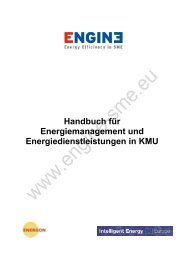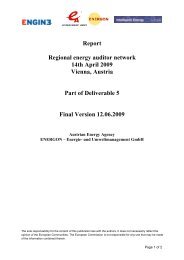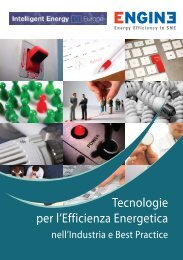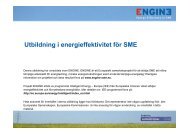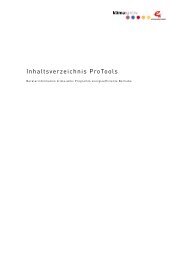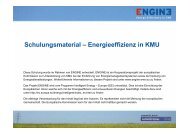- Page 1 and 2:
Training c
- Page 3 and 4:
Overview Energy Data Typical consum
- Page 5 and 6:
Characteristics Energy intense indu
- Page 7 and 8:
Euro per GJ Energy price trends -GA
- Page 9 and 10:
Contents of EN 16001 … standard f
- Page 11 and 12:
Energy Policy www.engine-sme.eu
- Page 13 and 14:
Formalised approach 1. Discuss the
- Page 15 and 16:
2/10. Clarify the process At an ear
- Page 17 and 18:
4/10. Inviting staff to participate
- Page 19 and 20:
6/10. Energy Policy - content • C
- Page 21 and 22:
Example Energy Policy SCA HYGIENE P
- Page 23 and 24:
8/10. Final Energy Policy The proje
- Page 25 and 26:
10/10. Updating the policy The ener
- Page 27 and 28:
The initial review The goal of the
- Page 29 and 30:
Step by step process The initial re
- Page 31 and 32:
Define operating conditions The eff
- Page 33 and 34:
Human factors Beside the technical
- Page 35 and 36:
Data source: Invoices Invoices pres
- Page 37 and 38:
Calculating data - options • To i
- Page 39 and 40:
Data source: Measurements The first
- Page 41 and 42:
Meter requirements • Make sure th
- Page 43 and 44:
EXAMPLE Data preparation The follow
- Page 45 and 46:
EXAMPLE Absolute and relative indic
- Page 47 and 48:
Input-Output analysis Input Output
- Page 49 and 50:
Flow chart With the data collected
- Page 51 and 52:
Analysis and interpretation Current
- Page 53 and 54:
Legal Obligations www.engine-sme.eu
- Page 55 and 56:
Legal obligations STEPS 1. Decide w
- Page 57 and 58:
Energy Programme www.engine-sme.eu
- Page 59 and 60:
Establish the procedure Within the
- Page 61 and 62:
Gathering proposals There are 2 use
- Page 63 and 64:
Improvement proposals on site Staff
- Page 65 and 66:
Cost Benefit Diagram Field A has th
- Page 67 and 68:
Scoring system Another efficient pr
- Page 69 and 70:
Scoring system 3. Assessment - Each
- Page 71 and 72:
Financial assessment 1. Static inve
- Page 73 and 74:
Static methods The costs of an inve
- Page 75 and 76:
Implementation of proposals In prac
- Page 77 and 78:
Identification of savings Apportion
- Page 79 and 80:
The Energy Programme If tasks are v
- Page 81 and 82:
Resources, Roles and Responsibiliti
- Page 83 and 84:
Energy Manager & Energy Team The to
- Page 85 and 86:
The Energy Team Members of the ener
- Page 87 and 88:
Resources • timetable • budget
- Page 89 and 90:
Awareness raising In the area of in
- Page 91 and 92:
Top management Top management must
- Page 93 and 94:
Provide necessary information The i
- Page 95 and 96:
Data, indicators and performance
- Page 97 and 98:
Possibilities to reduce losses Gene
- Page 99 and 100:
Awareness raising Awareness is the
- Page 101 and 102:
Staff participation - Check 1. What
- Page 103 and 104:
Communication Data about the Energy
- Page 105 and 106:
Methods 1. Indicators 2. Informatio
- Page 107 and 108:
Information in text form In 2003 th
- Page 109 and 110:
Information in graphs MWh 10000 800
- Page 111 and 112:
The communication network For each
- Page 113 and 114:
Structure of an Energy report Execu
- Page 115 and 116:
EM System documentation The primary
- Page 117 and 118:
Document control • Date stamped (
- Page 119 and 120:
4.4.5 Control of documents 1. Docum
- Page 121 and 122:
Operational control As a rule of th
- Page 123 and 124:
Energy Monitoring www.engine-sme.eu
- Page 125 and 126:
... gives information Before energy
- Page 127 and 128:
Core areas When setting up an energ
- Page 129 and 130:
Results An energy monitoring asks f
- Page 131 and 132:
Electricity Company Energy monitori
- Page 133 and 134:
Natural gas In some countries, e.g.
- Page 135 and 136:
Results 1: Energy consumption Energ
- Page 137 and 138:
Results 3: Average energy costs Ene
- Page 139 and 140: Evaluation of Compliance www.engine
- Page 141 and 142: Register of compliance Relevant act
- Page 143 and 144: Nonconformity, corrective and preve
- Page 145 and 146: Control of Records www.engine-sme.e
- Page 147 and 148: Records needed • Training
- Page 149 and 150: Document control • Revision Dates
- Page 151 and 152: General requirements for all record
- Page 153 and 154: Internal Audit www.engine-sme.eu
- Page 155 and 156: Areas to cover within an audit The
- Page 157 and 158: 2. Energy data • Data is classifi
- Page 159 and 160: 4. Energy team • In larger organi
- Page 161 and 162: 6. Energy programme • The improve
- Page 163 and 164: 8. Legal obligations • There is a
- Page 165 and 166: 10. Energy intensive areas • Ener
- Page 167 and 168: 12. Maintenance • Energy intensiv
- Page 169 and 170: 14. Training • T
- Page 171 and 172: 16. EM System documentation • The
- Page 173 and 174: The audit team • The members of t
- Page 175 and 176: EXAMPLE Audit Overview Office Produ
- Page 177 and 178: Audit procedure 1. The Audit team m
- Page 179 and 180: Review by top management Top manage
- Page 181 and 182: Compressed Air www.engine-sme.eu
- Page 183 and 184: Checking the efficiency Since poor
- Page 185 and 186: Analysis & calculation - 12 steps T
- Page 187 and 188: Step 2: Measure the consumption of
- Page 189: Step 4: Compare the specific energy
- Page 193 and 194: Step 5: Calculating losses from lea
- Page 195 and 196: EXAMPLE - Calculating losses from l
- Page 197 and 198: Step 6: Calculating the effective p
- Page 199 and 200: Step 7: Calculate pressure in distr
- Page 201 and 202: Step 8: Loss of pressure through sy
- Page 203 and 204: Step 10: Decrease of efficiency thr
- Page 205 and 206: Step 12: Choosing the off-load/ on-
- Page 207 and 208: EXAMPLE - track the efficiency . da
- Page 209 and 210: EXAMPLE - wast heat: track the effi
- Page 211 and 212: Electric Motors www.engine-sme.eu
- Page 213 and 214: Life-time facts • Almost half of
- Page 215 and 216: Main components The following compo
- Page 217 and 218: Losses in a motor system The main p
- Page 219 and 220: Motor applications The following ap
- Page 221 and 222: 1. Switch it off The simplest metho
- Page 223 and 224: Permitted starts/hour 1. Switch it
- Page 225 and 226: 2. Reducing motor load There is lit
- Page 227 and 228: 4. Use motor control systems Variab
- Page 229 and 230: 6. Reconnect to STAR ‘STAR’ con
- Page 231 and 232: 7. Motor sizing It has been enginee
- Page 233 and 234: Calculating the energy consumption
- Page 235 and 236: Calculating the energy consumption
- Page 237 and 238: Calculating the energy consumption
- Page 239 and 240: EXAMPLE Calculating annual costs Mo
- Page 241 and 242:
Example: Comparing investment and r
- Page 243 and 244:
EXAMPLE Comparing HEF and normal mo
- Page 245 and 246:
Heating systems This module focuses
- Page 247 and 248:
Losses in a heating system As a rul
- Page 249 and 250:
Heat source and boiler • Oil boil
- Page 251 and 252:
Tube systems Heat in the form of ho
- Page 253 and 254:
Controls Controls allow you to regu
- Page 255 and 256:
Fuels Today fossil fuels such as oi
- Page 257 and 258:
Calculating running costs for heati
- Page 259 and 260:
Step 1: Identify heated area Identi
- Page 261 and 262:
Step 3: Develop an indicator All yo
- Page 263 and 264:
Reducing energy consumption Reducin
- Page 265 and 266:
B. Energy optimisation with simple
- Page 267 and 268:
Reduce room temperature at specifie
- Page 269 and 270:
Decrease heat losses through window
- Page 271 and 272:
Reduce boiler temperatures Hot wate
- Page 273 and 274:
Adjust preflux temperatures correct
- Page 275 and 276:
Adjust thermostat valves Make sure
- Page 277 and 278:
Check frost detection devices Check
- Page 279 and 280:
Hydraulic regulation of the heating
- Page 281 and 282:
Losses caused by emitted heat in ex
- Page 283 and 284:
Distribution losses During operatio
- Page 285 and 286:
Humidity and its influence on comfo
- Page 287 and 288:
Reduce costs by changing fuels and
- Page 289 and 290:
Lighting www.engine-sme.eu
- Page 291 and 292:
Lighting facts Lighting can be a bi
- Page 293 and 294:
a. Single rooms The lighting system
- Page 295 and 296:
c. Direct and indirect lighting Dir
- Page 297 and 298:
Light yield lm/W Life time hour Pur
- Page 299 and 300:
Requirements for illumination Illum
- Page 301 and 302:
Evenness of lighting Type of work E
- Page 303 and 304:
Evaluating costs for lighting It is
- Page 305 and 306:
Step 2 - Identify annual operating
- Page 307 and 308:
Making energy savings 1. First, foc
- Page 309 and 310:
Use of daylight Staff sometimes for
- Page 311 and 312:
Reduce lighting level Daylight cont
- Page 313 and 314:
Interiors and colours When decorati
- Page 315 and 316:
Use control systems Control systems
- Page 317 and 318:
Ventilation systems This module wil
- Page 319 and 320:
Background information Traditionall
- Page 321 and 322:
Background information There are di
- Page 323 and 324:
Natural ventilation There are many
- Page 325 and 326:
Ventilation rates The quantity of v
- Page 327 and 328:
Facts The amount of energy consumed
- Page 329 and 330:
Components A ventilation system con
- Page 331 and 332:
Efficiency of fans Fan connections
- Page 333 and 334:
Specific Fan Power There are now st
- Page 335 and 336:
Air-cleaning and filtration systems
- Page 337 and 338:
Electric heating batteries An elect
- Page 339 and 340:
Heat recovery systems In a ventilat
- Page 341 and 342:
Control systems Ideally, buildings
- Page 343 and 344:
Evaluating the energy consumption E
- Page 345 and 346:
Evaluating the energy consumption A
- Page 347 and 348:
Example - energy consumption B. Bas
- Page 349 and 350:
Making energy savings The energy us
- Page 351 and 352:
Example Ventilation rates Office bu
- Page 353 and 354:
Example Ventilation rates Office bu
- Page 355 and 356:
Energy savings - 4. Use of control
- Page 357:
Summary Industrial ventilation gene



